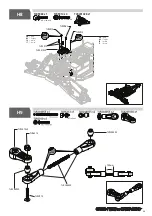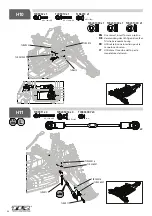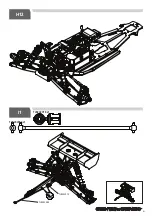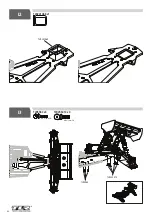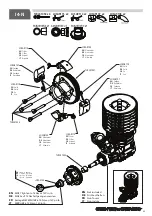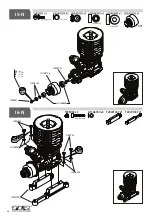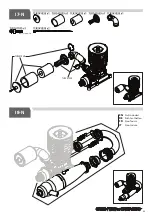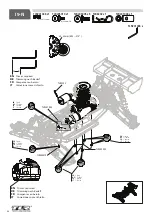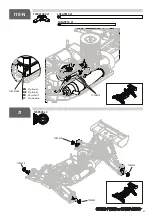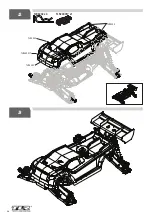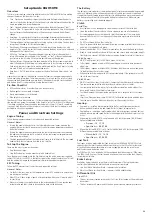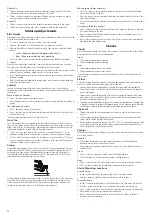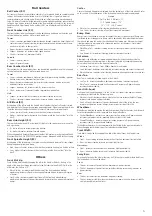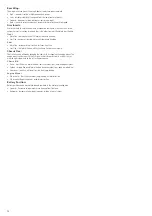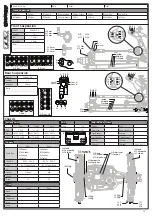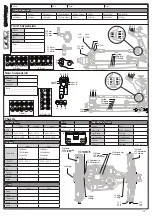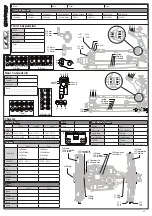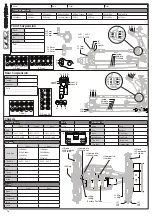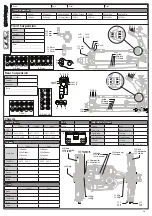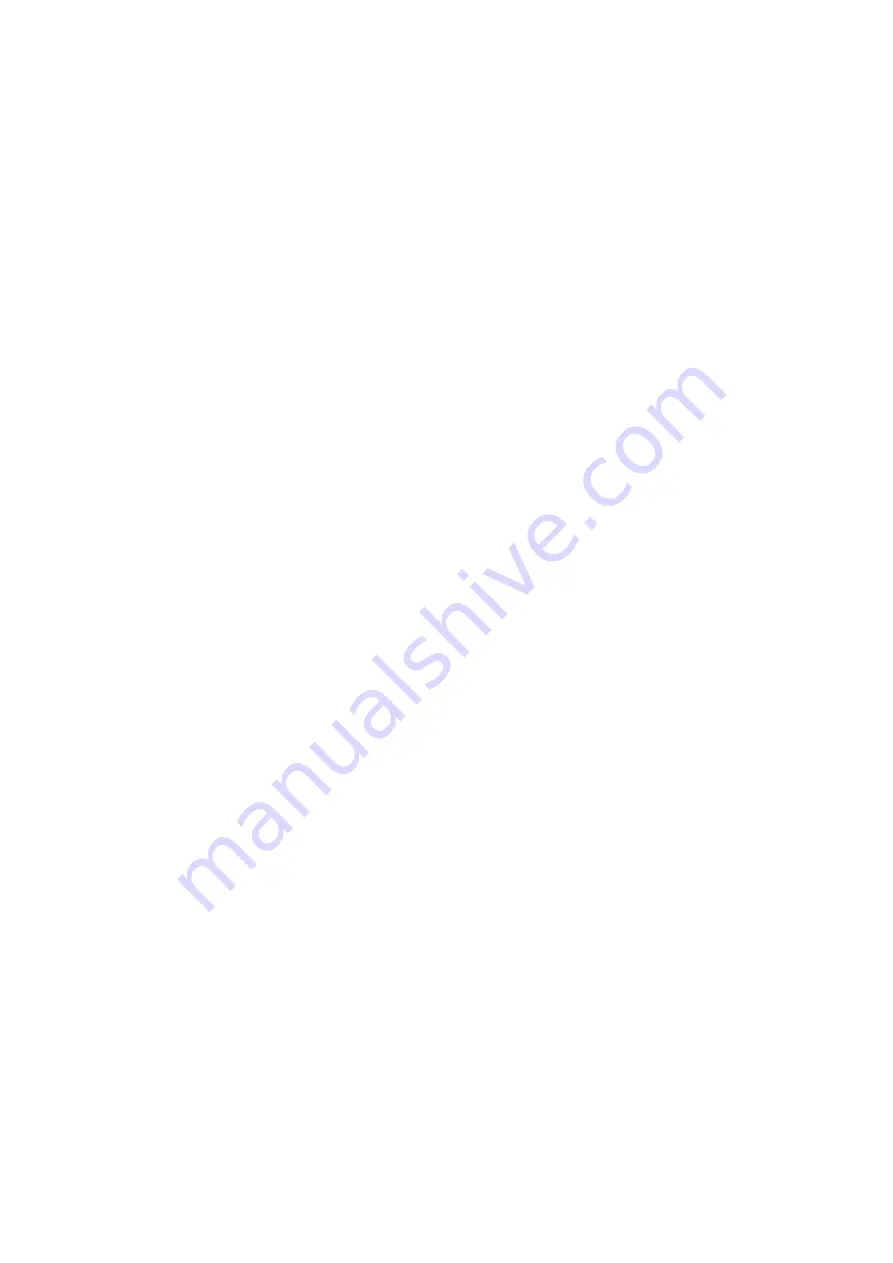
Roll Centers
Roll Center (RC)
Roll center is the point in space that a vehicle rolls at or around based on complete vehicle
settings. Roll centers can be affected by a lot of different items. Typically, a lower roll
center produces more traction and will cause the roll effect to produce more downward
force. A higher roll center helps the rear end to square up better and helps reduce traction
rolling on high traction surfaces. Balance of the front and rear roll centers is key for a well
handling vehicle. Adjustments below noted with RC are all adjustments that affect roll
centers.
Front Camber Link (RC)
The front camber link mounting points can be adjusted up and down on the inside and
outside (with option parts) as well as moved in and out.
Tower
• Lower – increases camber gain (camber change through suspension travel), higher roll
center, increases off-power steering, increases aggressiveness, decreases consistency,
good on small, tight, or bumpy tracks.
• Upper – decreases camber gain camber gain, lower roll center.
• Longer – decreases roll, increases high speed steering.
• Shorter – increases roll, decreases stability.
Spindle
• Lower – lower roll center.
• Upper – higher roll center.
Rear Camber Links (RC)
The rear camber link mounting positions can be adjusted up and down on the inside and
outside (with option parts) as well as moved in and out.
Tower
• Lower – increases camber gain, higher roll center, improves bump handling, increases
traction corner entry, decreases traction rolling.
• Upper – decreases camber gain, lower roller center, increases traction corner exit,
decreases traction corner entry.
• Longer – decreases roll, increases stability, increases traction.
• Short – increases roll, increases steering, improves bump handling.
Hub
• Longer – increases stability corner entry, increases steering corner exit.
• Shorter – increases steering corner entry, increases traction corner exit.
A/B Block (RC)
By changing of the pills in both the A and B block together, the front roll center is raised
and lowered. It also changes bone plunge and camber gains. When lowering the pills, also
lower the inner front camber link one hole to match, vice-versa for raising the pills.
• Lower - lower roll center, increases front traction, increases steering.
• Higher – higher roll center, decreases front traction, make the front not feel “into the
track”.
Rear Hub Height (RC)
The rear hub can be raised (B) or lowered (A) relative to the suspension arm, moving the
axle up or down.
• A – lower roll center, increases rear side traction.
• B – higher roll center, increases forward traction.
When changing hub height, different inner camber link locations may be required. The 8X
Aluminum Rear Hub Set (TLR334034) provides settings between A and B for fi ner tuning.
Front Spindle Height (RC)
By changing of the spindle shims, the spindle can be raised and lowered. This can change
bone plunge, bump steer, and droop.
• High - lower roll center, increases front traction, increases steering, less traction rolling.
• Low – higher roll center, decreases front traction, make the front not feel “into the
track”.
Others
Front Kick-Up
Front Kick-Up is adjusted by changing the pills in the A and/or B blocks. Kick up is the
angle of the inner front hinge pins relative to the fl at chassis plane. With 0/0 pills in the
A/B blocks, the kick up is 12°.
• More Kick-Up – increases weight transfer on/off the front end when braking/
accelerating, increases off-power steering and forward traction, improves absorption
of bumps.
• Less Kick Up – decreases weight transfer on/off the front end when braking/
accelerating, decreases off-power steering and forward traction, worsens absorption of
bumps.
Caster
Caster is the angle kingpins are displaced from the vertical axis of the front wheels. Caster
on this vehicle is the combination of the kick-up angle and the spindle carrier angle.
Example
0/0 pills in the A & B blocks = 12°
17.5° Spindle Carrier = 17.5°
12° + 17.5° = 29.5° caster
• More Caster - decreases initial steering, good on bumpy tracks.
• Less Caster - increases steering, allows freer suspension movement.
Bump Steer
Bump Steer is the change in front toe throughout the front suspension travel. Bump steer
is affected by caster changes also. Bump steer is adjusted by the washer height between
the rod end and drag link and/or the rod end and the steering arm. More washer height
(steering turnbuckle more parallel to suspension arm) has less bump out. Less washer
height, more bump out.
• More Bump Out – smoother steering, decreases steering corner exit, good for bumpy
tracks.
• Less Bump Out – more direct steering, increases steering corner exit.
Ackerman
Ackerman is the difference in steering angle between the inside tire and outside tire
turning throughout the steering throw. Ackerman is adjusted by changing the mounting
hole used on the drag link for the steering turnbuckle.
• Ackerman, least to most – Front, Middle, Rear holes on draglink
• Less Ackerman – decreases initial steering, increases steering mid corner to corner exit.
• More Ackerman - increases initial steering, decreases steering mid corner to corner exit.
Rear Toe:
Rear Toe In is adjusted by changing pills in the D block.
• Less Toe In - increases wheelbase, decreases rear traction, increases top speed.
• More Toe In - increases forward traction corner exit, increases off-power steering,
increases braking stability.
Rear Anti-Squat
Anti-squat is adjusted changing pills in the C block. Anti-squat is the angle of the inner
rear hinge pins relative to the fl at chassis plane.
• More Anti-Squat – decreases side-to-side roll on the rear, improves height off jumps,
improves rear traction under acceleration.
• Less Anti-Squat – decreases off-power steering and side-to-side roll on the rear,
improves acceleration in small bumps, increases rear traction off-throttle.
Wheelbase:
Wheelbase is adjusted by moving the rear hub spacing within the rear arm. Hubs forward
for a shorter wheelbase or hubs rearward for a longer wheelbase.
• Shorter Wheelbase – increases on-power rear traction, increases off-power steering,
increases rear weight transfer, generally better on tight or slick tracks
• Longer Wheelbase – increases on-power steering, decreases off-power steering,
increases stability, improves bump handling
*Wheelbase characteristics can sometimes also be affected by the type rear driveshafts.
When changing rear driveshaft types, test wheelbase settings again.
Track Width:
Track width is adjusted by changing the width of the wheel hexes, front and/or rear.
Wider:
• Front – slows steering response, decreases front traction, decreases traction rolling.
• Rear – quickens steering response, increases front traction.
Narrower:
• Front – increases traction corner exit, decreases high speed stability.
• Rear – increases traction corner entry, increases high speed stability.
Sway Bars:
Sway bars help control the side to side sway (roll) of the chassis and distribute load from
the inside wheel to the outside wheel.
Front
• Thinner - increases off-power traction, decreases on-power steering.
• Thicker - decreases off-power traction, smoother steering corner entry, increases on-
power steering.
Rear
• Thinner - increases traction, decreases on-power steering.
• Thicker - increases stability mid corner, increases on-power steering, increases stability
on high speed, high traction tracks.
71
71
Summary of Contents for 8IGHT-XT
Page 1: ...TM TM ...
Page 20: ...M3 x 16mm CH TLR5934 x2 TLR242025 x1 TLR242025 TLR5934 20 20 D3 D4 ...
Page 28: ...M3 x 14mm BH TLR5910 x4 LOSA4433 x2 LOSA4433 TLR5910 28 28 D18 D19 ...
Page 54: ...TLR241013 x3 TLR241013 54 54 G12 N G11 E ...
Page 58: ...TLR241068 x1 M4 x 12mm FH TLR255013 x4 TLR241033 x1 TLR241068 TLR241033 TLR255013 58 58 H6 H7 ...
Page 61: ...TLR242018 x1 TLR242044 x1 OIL TLR242018 TLR242044 61 61 H12 I1 ...
Page 68: ...TLR8202 x4 TLR240017 x1 TLR240017 TLR8202 TLR8202 TLR8202 68 68 J2 J3 ...



